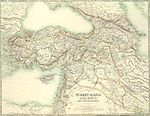
Back الأناضول ما قبل التاريخ Arabic پیشاتاریخ آناتولی Persian Anatolian esihistoria Finnish Préhistoire de l'Anatolie French اناطولیہ دی پرانی تریخ PNB Праисторија Анадолије Serbian Tarih öncesi Anadolu Turkish
This article needs additional citations for verification. (January 2024) |
| History of Turkey |
|---|
 |
| Timeline |
|
|
The prehistory of Anatolia stretches from the Paleolithic era[1] through to the appearance of classical civilisation in the middle of the 1st millennium BC. It is generally regarded as being divided into three ages reflecting the dominant materials used for the making of domestic implements and weapons: Stone Age, Bronze Age and Iron Age. The term Copper Age (Chalcolithic) is used to denote the period straddling the stone and Bronze Ages.
Anatolia (Turkish: Anadolu), also known by the Latin name of Asia Minor, is considered to be the westernmost extent of Western Asia. Geographically it encompasses the central uplands of modern Turkey, from the coastal plain of the Aegean Sea east to the western edge of the Armenian Highlands and from the narrow coast of the Black Sea south to the Taurus mountains and Mediterranean Sea coast.
The earliest representations of culture in Anatolia can be found in several archaeological sites located in the central and eastern part of the region. Stone Age artifacts such as animal bones and food fossils were found at Burdur (north of Antalya). Although the origins of some of the earliest peoples are shrouded in mystery, the remnants of Bronze Age civilizations, such as Troy, the Hattians, the Akkadian Empire, Assyria, and the Hittites, provide us with many examples of the daily lives of its citizens and their trade. After the fall of the Hittites, the new states of Phrygia and Lydia stood strong on the western coast together with Lykia and Caria. Only the threat from a distant Persian kingdom prevented them from advancing past their peak of success.
- ^ "1.2-Million-Year-Old Stone Tool Unearthed in Turkey". Archived from the original on 2020-11-11. Retrieved 2014-12-25.
© MMXXIII Rich X Search. We shall prevail. All rights reserved. Rich X Search